 |
 |
 |
| |
MITOCHONDRIAL DNA, COGNITIVE FUNCTION, AND FRAILTY IN OLDER ADULTS WITH HIV
|
| |
| |
CROI 2020
Reported by Jules Levin
Carrie Johnston1, Michelle Rice1, Heather Derry1, Chelsie Burchett1, Eugenia Siegler1, Mary Choi1, Marshall Glesby1
1Weill Cornell Medicine, New York, NY, USA
Abstract Body:
Older PLWH experience more comorbidities and geriatric syndromes, including cognitive impairment and frailty. Mitochondrial DNA (mtDNA), released from dying cells, is a biomarker of inflammation, a mediator of immune activation and has been detected at elevated levels in the plasma of PLWH. We hypothesized that in older PLWH, plasma mtDNA would be associated with lower cognitive performance, frailty, and higher serum IL-6 level.
We analyzed cross-sectional data from PLWH over age 55 at a single urban medical center. Participants completed a psychosocial questionnaire, biomedical visit, cognitive assessment (Montreal Cognitive Assessment, MoCA) and frailty testing by Fried criteria. Plasma and urine cell-free mtDNA were measured by qPCR detection of mitochondrial NADH dehydrogenase-1.
There were 164 participants; mean age 61 (SD: 6) range 54-87 years. One-third (55) were female. Half identified as Black, 29% as White, and 21% as other. Median time living with HIV was 25 years (IQR 22-29). The majority (93%) had HIV-1 viral load <200 copies/mL and median CD4 count was 582 cells/uL (IQR 402-795). Geometric mean mtDNA level in plasma was 221 copies/l (geometric SD: 2) and 2.4x108 copies/gram of urine creatinine (geometric SD: 4) in urine. Levels of plasma and urine mtDNA (Spearman correlation rho, =0.05, p=0.54) were unrelated. Median MoCA score was 24 (IQR 21-26); 63 (39%) scored <23. 49 (30%) were non-frail, 95 (58%) pre-frail and 20 (12%) frail. Age was not related to MoCA score (=-0.1, p=0.19), but was associated with frailty status by Jonckheere-Terpstra (JT) test (p=0.008). Plasma mtDNA level was higher in those with low MoCA score (p=0.028) by t-test [Figure 1]. Higher plasma mtDNA level was associated with slow walk (p=0.007) and exhaustion (p=0.04), but not weight loss (p=0.62), grip strength (p=0.06), low physical activity (p=0.71) or composite frailty score (p=0.98). Serum IL-6 levels were associated with frailty status (p=0.018) but not with low MoCA score (p=0.89 by JT). Neither plasma nor urine mtDNA levels were correlated with IL-6 level, -0.05 (p=0.55) and 0.09 (p=0.29), respectively.
In this study we show a relationship between elevated levels of plasma mtDNA and lower performance on the MoCA, greater exhaustion, and slower walk, suggesting mtDNA may have a role as a novel biomarker in assessing pathogenic inflammation associated with cognitive dysfunction and some components of frailty in PLWH.
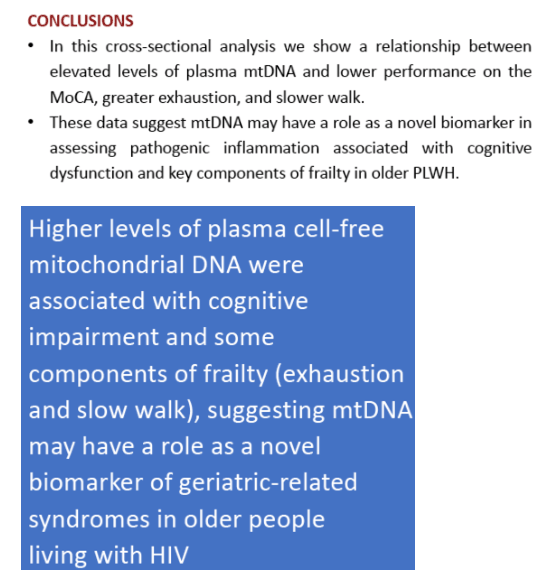
Program Abstract
Older PLWH experience more comorbidities and geriatric syndromes, including cognitive impairment and frailty. Mitochondrial DNA (mtDNA), released from dying cells, is a biomarker of inflammation, a mediator of immune activation and has been detected at elevated levels in the plasma of PLWH. We hypothesized that in older PLWH, plasma mtDNA would be associated with lower cognitive performance, frailty, and higher serum IL-6 level.
We analyzed cross-sectional data from PLWH over age 55 at a single urban medical center. Participants completed a psychosocial questionnaire, biomedical visit, cognitive assessment (Montreal Cognitive Assessment, MoCA) and frailty testing by Fried criteria. Plasma and urine cell-free mtDNA were measured by qPCR detection of mitochondrial NADH dehydrogenase-1.
There were 164 participants; mean age 61 (SD: 6) range 54-87 years. One-third (55) were female. Half identified as Black, 29% as White, and 21% as other. Median time living with HIV was 25 years (IQR 22-29). The majority (93%) had HIV-1 viral load <200 copies/mL and median CD4 count was 582 cells/uL (IQR 402-795). Geometric mean mtDNA level in plasma was 221 copies/l (geometric SD: 2) and 2.4x108 copies/gram of urine creatinine (geometric SD: 4) in urine. Levels of plasma and urine mtDNA (Spearman correlation rho, =0.05, p=0.54) were unrelated. Median MoCA score was 24 (IQR 21-26); 63 (39%) scored <23. 49 (30%) were non-frail, 95 (58%) pre-frail and 20 (12%) frail. Age was not related to MoCA score (=-0.1, p=0.19), but was associated with frailty status by Jonckheere-Terpstra (JT) test (p=0.008). Plasma mtDNA level was higher in those with low MoCA score (p=0.028) by t-test [Figure 1]. Higher plasma mtDNA level was associated with slow walk (p=0.007) and exhaustion (p=0.04), but not weight loss (p=0.62), grip strength (p=0.06), low physical activity (p=0.71) or composite frailty score (p=0.98). Serum IL-6 levels were associated with frailty status (p=0.018) but not with low MoCA score (p=0.89 by JT). Neither plasma nor urine mtDNA levels were correlated with IL-6 level, -0.05 (p=0.55) and 0.09 (p=0.29), respectively.
In this study we show a relationship between elevated levels of plasma mtDNA and lower performance on the MoCA, greater exhaustion, and slower walk, suggesting mtDNA may have a role as a novel biomarker in assessing pathogenic inflammation associated with cognitive dysfunction and some components of frailty in PLWH.
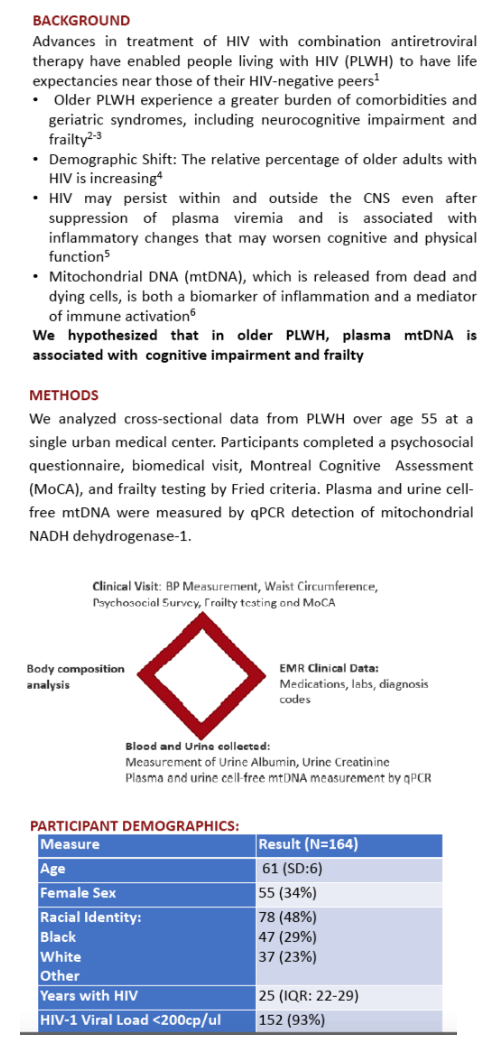
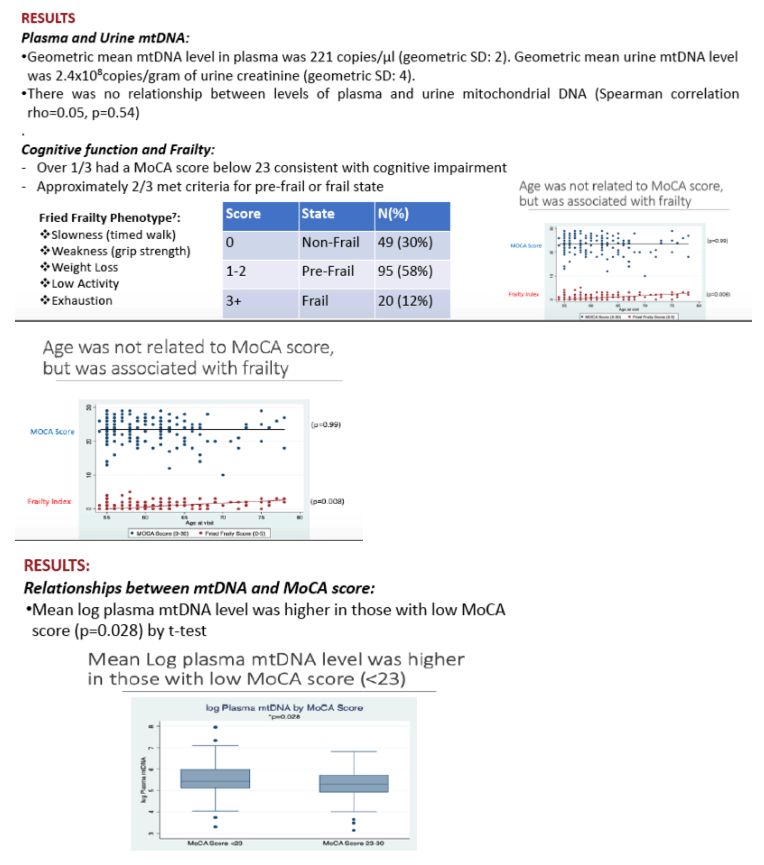
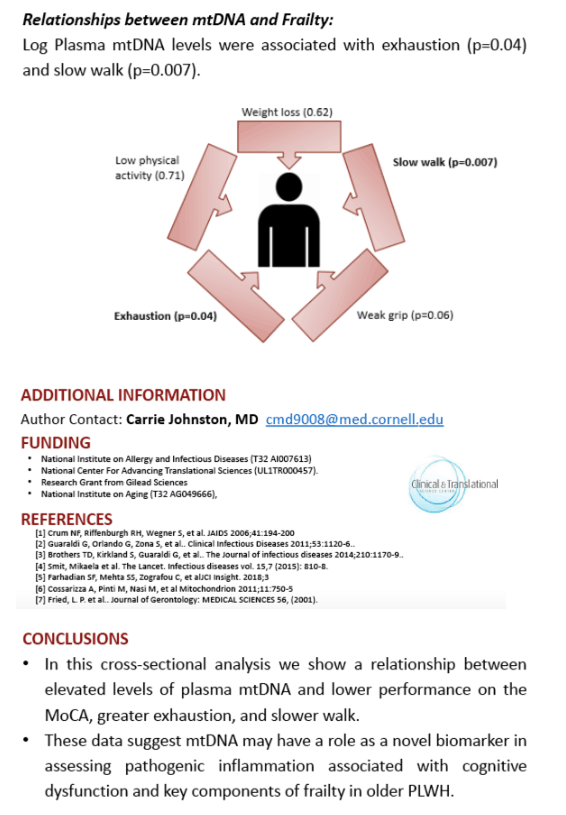
Program Abstract
Older PLWH experience more comorbidities and geriatric syndromes, including cognitive impairment and frailty. Mitochondrial DNA (mtDNA), released from dying cells, is a biomarker of inflammation, a mediator of immune activation and has been detected at elevated levels in the plasma of PLWH. We hypothesized that in older PLWH, plasma mtDNA would be associated with lower cognitive performance, frailty, and higher serum IL-6 level.
We analyzed cross-sectional data from PLWH over age 55 at a single urban medical center. Participants completed a psychosocial questionnaire, biomedical visit, cognitive assessment (Montreal Cognitive Assessment, MoCA) and frailty testing by Fried criteria. Plasma and urine cell-free mtDNA were measured by qPCR detection of mitochondrial NADH dehydrogenase-1.
There were 164 participants; mean age 61 (SD: 6) range 54-87 years. One-third (55) were female. Half identified as Black, 29% as White, and 21% as other. Median time living with HIV was 25 years (IQR 22-29). The majority (93%) had HIV-1 viral load <200 copies/mL and median CD4 count was 582 cells/uL (IQR 402-795). Geometric mean mtDNA level in plasma was 221 copies/l (geometric SD: 2) and 2.4x108 copies/gram of urine creatinine (geometric SD: 4) in urine. Levels of plasma and urine mtDNA (Spearman correlation rho, =0.05, p=0.54) were unrelated. Median MoCA score was 24 (IQR 21-26); 63 (39%) scored <23. 49 (30%) were non-frail, 95 (58%) pre-frail and 20 (12%) frail. Age was not related to MoCA score (=-0.1, p=0.19), but was associated with frailty status by Jonckheere-Terpstra (JT) test (p=0.008). Plasma mtDNA level was higher in those with low MoCA score (p=0.028) by t-test [Figure 1]. Higher plasma mtDNA level was associated with slow walk (p=0.007) and exhaustion (p=0.04), but not weight loss (p=0.62), grip strength (p=0.06), low physical activity (p=0.71) or composite frailty score (p=0.98). Serum IL-6 levels were associated with frailty status (p=0.018) but not with low MoCA score (p=0.89 by JT). Neither plasma nor urine mtDNA levels were correlated with IL-6 level, -0.05 (p=0.55) and 0.09 (p=0.29), respectively.
In this study we show a relationship between elevated levels of plasma mtDNA and lower performance on the MoCA, greater exhaustion, and slower walk, suggesting mtDNA may have a role as a novel biomarker in assessing pathogenic inflammation associated with cognitive dysfunction and some components of frailty in PLWH.
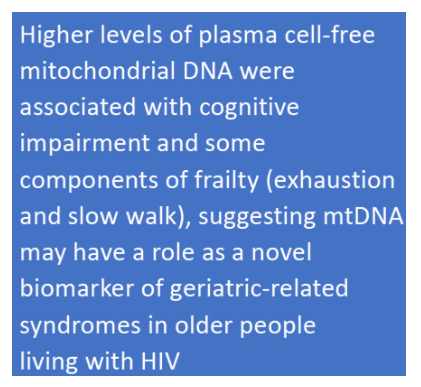
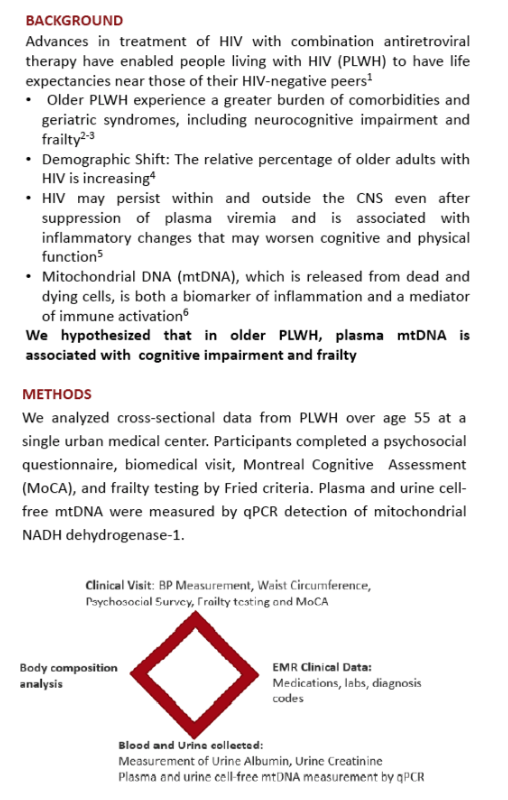
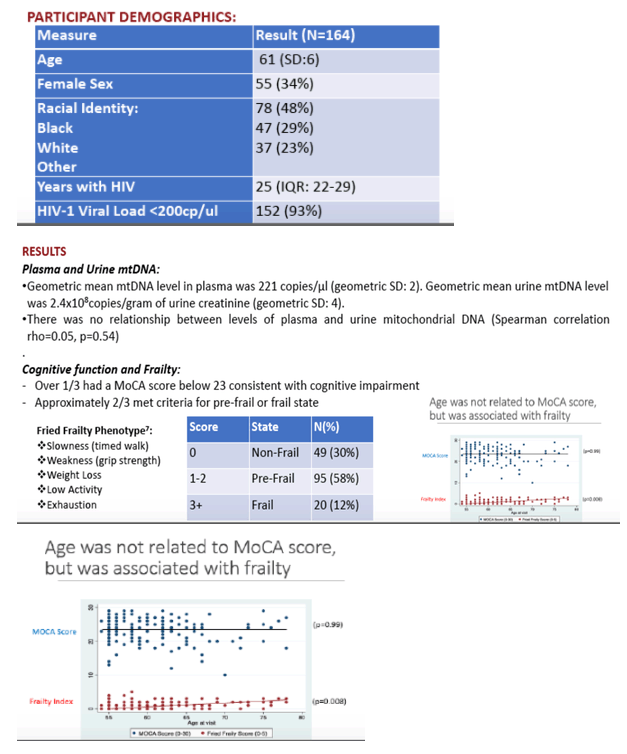
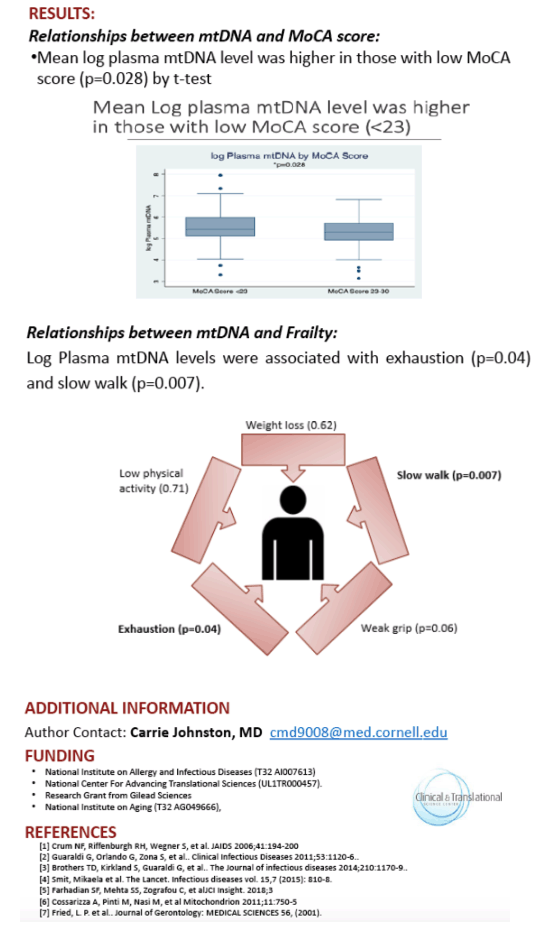
|
| |
|
 |
 |
|
|